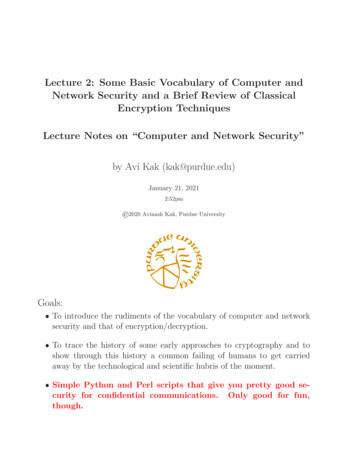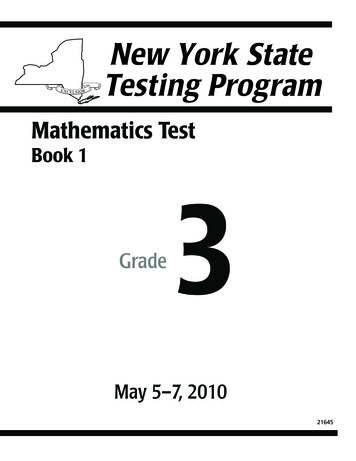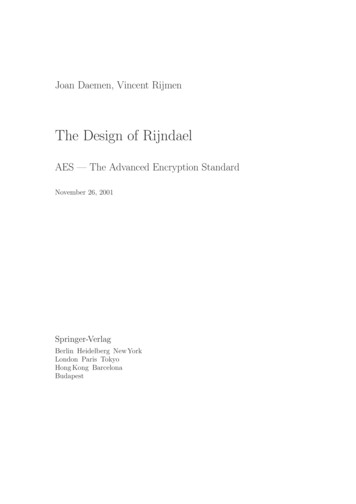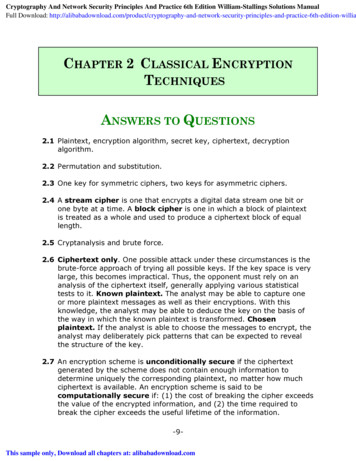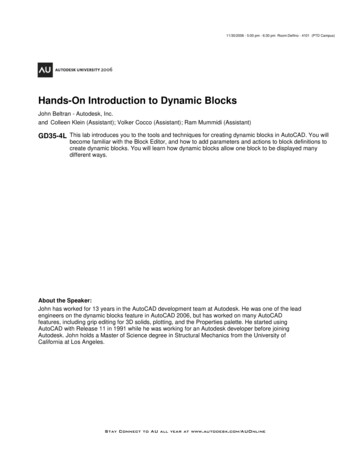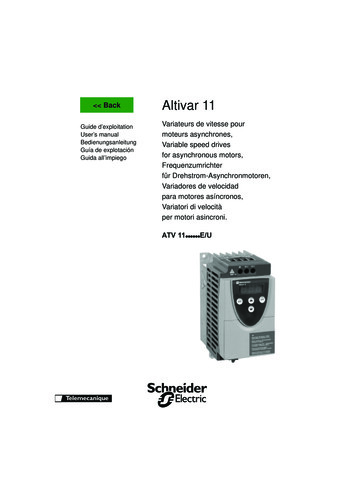
Transcription
Block Cipher Speed and Energy EfficiencyRecords on the MSP430:System Design Trade-Offs for 16-bit EmbeddedApplications?Benjamin Buhrow, Paul Riemer, Mike Shea, Barry Gilbert, and Erik DanielMayo Clinic, Rochester, MN, USAbuhrow.benjamin@mayo.edu, riemer.paul@mayo.edu, shea.michael@mayo.edu,gilbert.barry@mayo.edu, daniel.erik@mayo.eduAbstract. Embedded microcontroller applications often experience multiple limiting constraints: memory, speed, and for a wide range of portabledevices, power. Applications requiring encrypted data must simultaneously optimize the block cipher algorithm and implementation choiceagainst these limitations. To this end we investigate block cipher implementations that are optimized for speed and energy efficiency, theprimary metrics of devices such as the MSP430 where constrained memory resources nevertheless allow a range of implementation choices. Theresults set speed and energy efficiency records for the MSP430 deviceat 132 cycles/byte and 2.18 µJ/block for AES-128 and 103 cycles/byteand 1.44 µJ/block for equivalent block and key sizes using the lightweightblock cipher SPECK. We provide a comprehensive analysis of size, speed,and energy consumption for 24 different variations of AES and 20 different variations of SPECK, to aid system designers of microcontrollerplatforms optimize the memory and energy usage of secure applications.Keywords: AES, SPECK, lightweight, encryption, MSP430, speed, energy, efficient, measurements, trade-offs1IntroductionMany lightweight block ciphers have been established in recent years in responseto the growing use of resource-constrained electronic devices in a wide varietyof embedded applications. Examples include TWINE [1], Piccolo [2], Lblock [3],LED [4], PRESENT [5], SIMON, and SPECK [6], in addition to the mainstayAES [7]. Lightweight block ciphers are largely targeted or optimized for smallhardware implementations although some are specifically architected to admitsoftware-friendly designs for microcontrollers (e.g., TWINE and SPECK).Microcontroller based software applications occupy an interesting middleground: resources are very constrained relative to general purpose 32- or 64bit processors but they are abundant relative to devices like RFID tags or smart?The final publication will be available at Springer via the Latincrypt 2014 proceedings
cards. For example, sensor nodes like the MicaZ [8] or TelosB [9] utilize microcontroller devices that offer enough ROM and RAM to implement large lookuptables or to unroll program loops. Further, the programmable nature of microcontrollers provides support for diverse applications, each with a different set ofresource requirements, of which the block cipher is typically only a small part.Outside of choosing different block cipher algorithms, the ability to tailor a particular algorithm to the device resources at hand is desirable; for example whenan algorithm provides exceptional security or energy efficiency.Overall, many parameters of block ciphers are important to an embeddedsystem designer such as size, security, speed, and energy efficiency, dependingon the application. Varying a block cipher’s implementation strategy within embedded devices is a relatively unexplored topic, and one that can provide muchin the way of trade-off data to designers. Survey authors do a thorough evaluation over many different ciphers (e.g., [10], [11], and [12]), but in many casesone implementation strategy (e.g., small size versus high speed or C languageversus assembly language [hereafter, abbreviated to assembler]) is chosen percipher without much discussion. In this paper we quantitatively discuss thisissue by measuring multiple implementations of two algorithms: AES and thelightweight block cipher SPECK. These were chosen for two primary reasons:both are expected to have good performance on the MSP430 [13] and each canbe implemented in a variety of ways on 16-bit platforms that trade off size forspeed. We focus on SPECK over other lightweight block ciphers because 1) itis a very recently proposed cipher and its implementation has not been fullyexplored on the MSP430 platform and 2) the wide range of block and key sizesin SPECK are interesting from the standpoint of configurablity. The intent isnot to promote one algorithm as ”better” or ”worse” than the other - their designs are sufficiently different to preclude such a comparison. Nor is the intent toprovide security analysis of either algorithm, other than by increasing key sizes.The goals are to provide system designers data and analysis over a wider rangeof size, speed, and energy efficiency than could be obtained from either blockcipher alone, and to discuss efficient implementations of each algorithm.The primary contributions of this paper are the presentation of a matrix ofsize, speed, and energy consumption data for 8 different implementation strategies of AES coupled with its 3 different key sizes and a first look at similarlythorough results for the entire family of 10 different SPECK parameterizations,for both C and assembler implementations. The thorough analysis across AESimplementation strategies on the MSP430 presented here is unavailable elsewhere in the literature, to our knowledge. SPECK is a relatively new cipherand the implementations here represent the most thorough to date. Our fastest128-bit implementations operate at 132 cycles/byte for AES-128 and 103 cycles/byte for SPECK-128, both setting speed records for 128-bit block cipherson the MSP430. Measured energy of 2.18 µJ/block for AES and 1.44 µJ/blockfor SPECK fit in at numbers 5 and 6 in Guneysu’s list of top energy efficient AESimplementations for any platform [14], but notably the results are considerablymore efficient than all other microcontroller platforms tested in that report.
In addition, we provide C and assembler implementation tactics for our AESdesigns as well as a detailed review of SPECK implementations in C that improveperformance relative to conventional approaches. None of the implementationstrategies used here for AES are new; however the 16-bit optimization of Gouvea[15] is fairly recent and led to the record speed and energy efficiency results. Forall implementations we concentrate solely on encryption and omit decryption.The remainder of the paper is organized as follows. In Section 2 we discussrelated work, in Section 3 the algorithms of study and their implementationvariations, in Section 4 efficient implementation details, in Section 5 the experimental setup, metrics, and results, and in Section 6 our conclusions.2Related WorkTo a system designer choosing a block cipher for adoption in a microcontrollerbased application, several relevant works exist. As previously mentioned, manylightweight block ciphers have been recently proposed and their authors typicallyoffer performance results and/or implementation tactics although the scope ofthese efforts varies. Several surveys help distill the relative performance of theselightweight and other block ciphers. For example Eisenbarth et al. in [10] providesresults of several ciphers on an 8-bit ATtiny45 device. The authors concentrate onsmall size as a design goal and provide energy consumption data but the resultsare of limited relevance to this study given the differences in target platform.Law et al. in [11] compares block ciphers on an MSP430F149 device. They adoptsource code from public sources such as OpenSSL [16]. This approach ensuresquality code, but fixes the implementation strategy to that of the public sourcethat is not necessarily optimized for embedded devices. Cazorla et al. in [12]compare 12 lightweight and 5 conventional block ciphers on an MSP430F1611device. The authors compare many ciphers, but understandably chose a singleimplementation for each and do not state any particular optimization goals.Didla in [17] investigates implementation tactics of AES in a MSP430F1611device; however, all are variations of AES for 8-bit platforms. Finally, in [18] theauthors compare AES with other block ciphers on both MSP430- and ATmegabased platforms. They address the variable key size of AES but otherwise choosea single implementation (unstated, but from their provided ROM size it appearsto be a table-based one).Concerning speed records for AES on microcontroller devices, Hyncica in [19]presents optimized AES results of 172 cycles/byte for the MSP430 platform thatis based on 32-bit table-based code ported from LibTomCrypt [20]. Gouvea [15]first presented the 16-bit lookup table strategy for AES in which they reported180 cycles/byte on a MSP430 platform. On an AVR device the current speedrecord is described by Bos in [21], previously held by Poettering in [22].Implementation and analysis results have begun to appear for SPECK. Thedesigners present implementation results for SPECK on Atmels ATmega128 8bit processor and the BLOC project [13] provides preliminary performance dataon the MSP430. Cryptanalysis of SPECK can be found in [23], [24], and [25].
33.1Algorithms and Implementation VariationsAESThe AES algorithm uses a substitution-permutation approach and operates ona block size of 128-bits organized as a 4x4 array of bytes [7]. Four basic transformations are iteratively applied over a variable number of rounds (dependingon key size) to complete each block encryption. These operations are SubBytes,ShiftRows, MixColumns, and AddRoundKey. Of these, MixColumns is the mostcomplex operation requiring multiplication of state bytes by constants over theGalois Field GF(2)8 . Most of the AES implementation variations in common useconcern themselves with optimizing this transformation.Daemen and Rijmen in [26] discuss implementation aspects for both 8-bit and32-bit processors. In the 8-bit approach, SubBytes, ShiftRows, and AddRoundKey can be easily combined and executed byte-by-byte for each of the 16 inputbytes and the MixColumns step can also be implemented efficiently. In this paperthe 8-bit approach is implemented in 4 different ways. The first is optimized forspeed by unrolling all transformations within each round. It was adapted fromthe implementation provided by Texas Instruments (TI) in [27]. The second alsofollows [27], but condenses the transformations into nested loops to reduce ROMsize. The third and fourth variations further optimize for speed by introducingextra 256-byte lookup tables to speed up the field multiplications within MixColumns. In the sections below, these four 8-bit variations are referred to as8-BIT-UNROLL, 8-BIT-LOOPED, 8-BIT-2T, and 8-BIT-2SBOX, respectively.The 32-bit approach discussed by Daemen and Rijmen is also practical usingthe 16-bit instruction set of the MSP430. The matrix formulation of the roundtransformation can be used to define a set of four 256-entry 32-bit lookup tables,known as T-tables, for a total of 4096 precomputed and stored bytes. One iteration of the round function amounts to 16 table lookups and 16 XORs. Threeof the T-tables are byte rotations of the first T-table, thus as a space/speedtradeoff, 1024 bytes of storage can be used together with cyclic 8-bit shifts ofthe single table. Both of these 32-bit variations are implemented; in the sectionsbelow they are referred to as 32-BIT-4T and 32-BIT-1T, respectively.A new optimization was proposed by Gouvea [15] targeting 16-bit processors.This new approach is a variation of the 32-bit table lookup approach where 4tables of 16-bit entries are defined such that each of the original 32-bit tablescan be constructed by concatenating two of the 16-bit tables. This formulationreduces the memory requirement by a factor of 2. After initial tests showed thatthis variation was the best performing in terms of speed and energy consumption,it was also implemented in assembler. In the sections below these variations arereferred to as 16-BIT-4T and 16-BIT-4T-ASM, respectively.3.2SPECKSPECK is a family of lightweight block ciphers with a wide range of blockand key size choices and hence is potentially interesting to system designers
desiring trade-offs between size, speed, and security. SPECK is a Feistel-likealgorithm that uses the map Rk : GF(2)N GF(2)N GF(2)N GF(2)N ,where k GF(2)N , defined byRk (x, y) ((S α x y) k, S β y (S α x y) k)(1)where denotes bitwise XOR, denotes addition modulo 2N , S j , S j denoteleft and right circular shifts by j bits, and α, β are constants defined accordingto the block size chosen.The family of SPECK algorithms is defined according to Table 4.1 in [6],reproduced here for convenience in Table 1. We implemented each of the 10parameterizations of SPECK shown in Table 1 in both C and assembler. In thesections below we refer to these implementations by the version name with an-ASM or -C suffix for assembler or C, respectively.Table 1. SPECK parametersBlock size Key size Word size Key words Rotation Rotation Rounds T1443291281286428332 128-BIT1923332564344Implementation DetailsIn all cases the interface to the block ciphers consists of two byte-pointer arguments to an array of bytes to be encrypted and to the expanded key, respectively.We use IAR Embedded Workbench version 5.51 as a development platform. Thetarget device is the MSP430F5528.4.1AES 8-BITThe first 8-bit version of AES, 8-BIT-UNROLL, is based on the implementationby TI for the MSP430 [27] that makes use of the efficient 8-bit implementationhints given in [26].The 8-BIT-LOOPED version replaces the unrolled MixColumns step with aloop over the 4 columns of the state, and replaces the unrolled AddRoundKeystep with another loop over the 16 bytes of the state.
The 8-BIT-2T version replaces each AES GF(2)8 multiply-by-2, requiringtest, branch, shift, and XOR instructions with a single table lookup. The goalwith this version is to increase speed at the expense of program size, and increaseside-channel timing attack resistance (see Section 4.5).The 8-BIT-2SBOX version precomputes the 256-byte table 2Sbox 2 Sbox[a], where denotes multiplication in the Galois Field, for each input bytea. To see how this is effective, recall that the MixColumns step computes avector-matrix multiplication, for example, Sbox[a0 ]02 03 01 01b0 b1 01 02 03 01 Sbox[a1 ] b2 01 01 02 03 Sbox[a2 ] Sbox[a3 ]03 01 01 02b3(2)Also recall that in multiplication over GF(2)8 we have that 3 SBox[ax ] (2 SBox[ax ]) SBox[ax ] . Therefore multiplication of Sbox[ax ] by 1, 2, and 3 canbe done in a straightforward way by application of Sbox and 2Sbox. Once the rowshifts are folded into each column’s matrix-vector multiplication, clever orderingof the resulting systems of equations yields a very efficient implementation, asrealized by Pottering in [22]. We adapted his 8-bit AVR assembler code for theMSP430.4.2AES 32-BITThe two 32-bit versions of AES use the T-table approach as described by Daemenand Rijmen in section 4.2 of [26]. On 8-bit architectures this approach may not bepractical because each of the 32-bit table lookups would require 4 byte-lookups.In total, 64 byte-lookups and 64 XORs per round would be required, which iscomparable to the instruction count of a non-table-lookup approach. However on16-bit architectures 32 word-lookups and 32 XORs per round are required, thusthe overall instruction count is reduced quite a bit compared to 8-bit approaches.In our implementation, the input array of bytes to be encrypted is useddirectly as the state matrix. The state bytes are used to index the table lookupsand the resulting new columns are stored in four temporary 32-bit variables.These are XORed with a 32-bit pointer aliased to the expanded key byte-array.The results are stored back into the state matrix using a 32-bit pointer aliasedto the state byte-array. Aliasing the pointer allows access to the same data bytesat different granularity without use of temporary storage. Reducing temporarystorage is an important strategy in fast designs, (discussed further in Section4.5). Pointer aliasing is accomplished using casting, e.g.:state32 (uint32 t *)state;32-BIT-1T is very similar to the above, except T1, T2, and T3 are replacedwith T0 and macros to perform left circular byte shifts by 1, 2, and 3 bytesrespectively.
4.3AES 16-BITAs described by Gouvea in [15], the 32-bit lookup tables can be reduced to 16-bitlookup tables such that concatenations of two of the 16-bit tables can produceany of the original 32-bit tables. The pointer aliasing approach used in the 32bit case applies similarly to the 16-BIT-4T version. Of note, by directly using16-bit operations on 16-bit data types the compiler is no longer relied upon tosynthesize 16-bit instructions from source code using 32-bit operations on 32-bitdata types. Compilers are not perfect in this regard, so in addition to reducingthe memory footprint by a factor of two, this approach was found to be faster aswell. There is no equivalent byte-rotation-based memory/speed tradeoff in the16-bit approach as there is in the 32-bit approach.After initial testing, the 16-BIT-4T version of AES was found to be the fastestand lowest energy of all of the AES implementation variations tested. A completelisting of 16-BIT-4T can be found in Listing A in the Appendix. To furtherenhance the performance, 16-BIT-4T was also implemented in assembler, usingthe IAR generated assembler as a starting point. In the generated assembler, thecompiler was unable to utilize the 12 general purpose registers (R4-R15 [28]) ofthe MSP430 efficiently enough and thus required temporary data to be loadedfrom and stored to the stack (in RAM). As discussed in Section 4.5, accessingtemporary data in RAM is detrimental to speed.The following register scheme in our assembler version avoids storing temporary data to RAM, thus increasing the speed and further reducing the energyconsumption of the 16-BIT-4T-ASM code version. Registers R4 through R11 areused to hold the 8 temporary 16-bit column results, R12 and R13 hold pointers to the state array and expanded key respectively, R14 is the loop counter,and R15 is used to compute offsets into the tables. An excerpt of the resultingassembler round function is shown in the Appendix, Listing B.It is likely that other AES versions implemented in assembly language wouldalso see performance improvements. For instance, an assembler implementationof the 32-BIT-4T version could likely be made identical to the 16-BIT-4T-ASMversion, speed-wise, since in assembler the only difference would be differentoffsets into the larger 32-bit tables. Based on the preceeding reasoning, we limitour AES assembly language analysis to a single implementation variation; wedo not anticipate that 32-bit table-based variations re-implemented in assemblylanguage would exceed the performance of 16-BIT-4T-ASM.4.4SPECKThe round function of SPECK is very succinct; therefore all implementationsfully unroll the round function, leaving a single loop over the required number ofrounds. Beyond decisions like unrolling or not, or inlining or not, Beaulieu in [6]provides no guidance on implementation of the round function. In this sectionimplementations in C and assembly language are discussed.SPECK performs all operations modulo n, the word size. Whenever the Cdata type (e.g., uint32 t or uint64 t) is larger than the 16-bit processor word size,
then the compiler must translate XOR, addition ( ), and shift operations withinC code into multi-precision operations over the native 16-bit instructions of theMSP430 [28]. For example, let X {X3 , X2 , X1 , X0 } and Y {Y3 , Y2 , Y1 , Y0 }be 64-bit integers composed of 16-bit words Xi and Yi (0 i 4). AddingX Y in C would ideally result in the following sequence of operations in a16-bit instruction ddX0X1X2X3to Y0and previous carry to Y1and previous carry to Y2and previous carry to Y3C implementations may be preferred by developers (e.g., to simplify the coding effort), and our particular compiler generated efficient multi-precision codefor the XOR and addition operations within SPECK. However, the generatedcode for the circular shifts was not very efficient. Since at least one compiler appears to have difficulty generating efficient code for the SPECK round function,we also implement the round function in assembler to quantify the trade-off.The SPECK round function in most cases requires both a left circular shift(LCS) by 3 bits and a right circular shift (RCS) by 8 bits. The LCS can beimplemented in an efficient way in assembler using three one bit circular shifts,as follows, where 64 bits of data are stored in the four 16-bit registers R4 throughR7 :; assembly language 1-bit LCS; each instruction takes one clock cycle; (in register addressing mode)rla r4; shift first 16-bit wordrlc r5; shift with carry second 16-bit wordrlc r6; shift with carry third 16-bit wordrlc r7; shift with carry second 16-bit wordadc r4; rotate final carry back to first wordThe 8-bit RCS can be performed in assembler in an efficient way using swapbyte and XOR operations, as shown in Listing C on a 64-bit word held in registersR4-R7. Equivalent LCS and RCS operations in C were not as efficient. Forexample the RCS implemented as x (((x) 56) ((x) 8)), did not use anextra temporary register and final swap-byte/XOR, as in Listing C, instead usingtwo AND operations (in immediate mode), a swap-byte, and an OR operation.(The immediate addressing mode is slower than the register addressing mode onthe MSP430, two clock cycles versus one [28].)For developers who do not want to proceed to assembler there unfortunatelymay be limited options to optimize the multi-precision LCS/RCS operations.Typically there is not enough direct access to machine status words, for exampleto access/modify carry flags, or access to specialized instructions like ”rotateleft through carry” (rlc), from within high level languages such as C. Listing Din the Appendix shows the full implementation of SPECK-128 in C. The listing
illustrates different ways to implement LCS and RCS that resulted in an 8%speedup over versions that used the C language methods shown above.4.5MSP430 features and capabilitiesSeveral features of the MSP430 family of microcontrollers have direct bearingon the implementation results presented in Section 5. Chiefly, these are 1) theinstruction set, 2) the addressing modes, and 3) the register set. The MSP430Family User Guide [28] provides detailed information on all of these features. Inthis section, we offer comments on specific use of several of the features as theypertain to SPECK and AES implementations.Instructions on the MSP430 allow operations on either bytes or 16-bit words(via .b or .w suffixes). The swap bytes (swpb) instruction is very useful to SPECKimplementations (for the RCS operation). Byte operations to registers clear themost significant byte of the word; this effect is also used during the RCS operation (Appendix, Listing C).The addressing modes of the MSP430 include register modes (operations ondata held in processor registers) and several memory modes (operations on dataheld in processor memory, RAM or ROM). Operations on data held in memoryare generally much slower than data held in registers. For example, to XOR twowords held in processor registers takes one clock cycle, but to XOR two wordsheld in memory takes five or six clock cycles, depending on the specific addressingmode employed. As such, whenever possible AES and SPECK code is structuredto attempt to minimize loading from and storing to memory. Unfortunately thereare only 12 general purpose registers (designated R4 through R15) in which tohold data. A consequence of the limited register set is that temporary variablesmust be used very sparingly in C code. As the compiler encounters ”larger”numbers of temporary variables (e.g., function locals) it will utilize stack memory(physically stored in RAM) to hold them. Accessing these temporary values willtherefor incur a speed penalty due to slower memory addressing modes on theMSP430. We do not attempt to quantify ”larger” in this study, since detailedexamination of the compiler is not our goal (and will be different, for othercompilers). However, as the number of temporary variables grows it becomesmore difficult for the compiler to avoid temporary use of RAM-based stack.The MSP430’s addressing modes have the advantage that memory accessesare constant time. There are no cache hierarchy effects or interactions withother concurrently running processes to worry about [29]. AES versions thatuse table lookups thus do not have key- or input-dependent timing variabilityand appear to have resistance to timing attacks on the MSP430. In our suite ofimplementations, the only AES versions that do not use table lookups are 8-BITUNROLL and 8-BIT-LOOPED. In these implementations, the computation ofmultiply-by-2 over GF(2)8 depends on the input (a branch containing an extrainstruction may or may not be taken). We have not investigated the feasibilityof a timing attack on these AES implementations. The SPECK round functioninvolves no branches and on the MSP430 takes constant time. Based on theconstant time property of the round function, we expect SPECK to be resistant
to timing-based side-channel attacks on the MSP430, although this has not beeninvestigated.55.1Results and DiscussionExperimental Setup and ProcedureThe 8 variations of AES were evaluated for each of the 3 AES key sizes alongwith the 20 variations of SPECK (10 in C and 10 in assembler). The metrics foreach test were speed of encryption, code size, and energy consumption. Speedwas measured using the IAR debugger and function profiler tools in simulationmode. (Speed was also independently verified using timing information obtainedfrom the measured waveforms described below, running released code.) Code sizeis provided by the IAR linker, broken down into CODE, DATA, and CONSTsegment sizes. Since all CONST segment data is stored in ROM along withthe CODE segment, below we have grouped CODE and CONST together as atotal ROM size, reported along with total RAM size (DATA segments). Energyconsumption was calculated by first measuring the voltage drop across a 10 ohmresistor in series with the MSP430 digital voltage supply, Vdvcc , on a customevaluation board (nominally Vdvcc 2.85 V). Voltage drop was measured usinga National Instruments PXI-1024Q chassis, PXI-8108 controller, and PXI-40717 digit, 26-bit digitizer. Custom MATLAB scripts then converted the voltage tocurrent and performed integration of the current waveforms over the encryptiontime-period to get charge, Q. Finally, energy is calculated as E QVdvcc .In every case key expansion was performed and all round keys were stored inRAM (code to perform key expansion is included in our ROM figures; however,we omit key expansion speed results). (In most cases the key expansion speed iswithin a factor of 2 of the number of cycles for a block encryption.) Stack utilization also consumes RAM; stack usage was determined by careful examination ofcompiler generated code.5.2Results and DiscussionThe results are shown in Figures 1 through 5 below. Figure 1 shows the speeddata for each algorithm, arranged right-to-left from fastest to slowest. Figure2 through Figure 5 are presented in the same x-axis order as Figure 1, i.e., allresults are sorted according to speed. Figure 2 through Figure 5 show energyconsumption per byte, ROM size, RAM size, and a combined metric, the codesize cycle count product normalized by block size [10]. In all figures smallerbars are better. In the SPECK charts, ”Small Key” refers to the smaller of thekey options for each block size shown in Table 1. Similarly, ”Large Key” refersto the larger of the key options. The 256-bit key only applies to the 128-bit blocksize.For AES, the fastest and most energy efficient C implementation is the 16BIT-4T variation at 152 cycles/byte and 2.46 µJ/block. The speedup obtained
Fig. 1. Speed of AES (left) and SPECK (right) (Block encryption only) (44520)Fig. 2. Energy consumption per byte of AES (left) and SPECK (right) (44522)over Gouvea’s implementation [30] is due to the avoidance of storing the statematrix in temporary stack space. This was accomplished via the pointer aliasingtechnique discussed in Section 4.3: aliasing the input state array (uint8 t *),used to index the lookup tables, with a word-array pointer (uint16 t *), usedfor assignments to the state matrix. The 16 extra stack bytes in Gouvea’s roundfunction implementation cause more data movement to and from RAM that inaddition to adding instructions, incurs the memory addressing mode cycle-countpenalty discussed in Section 4.5.The assembler implementation 16-BIT-4T-ASM gives a further 14% speedupand 12% decrease in energy usage over the C implementation, to 132 cycles/byteand 2.18 µJ/block. This improvement is again a direct consequence of improvingregister utilization (and thus reducing the memory addressing mode cycle-countpenalty). The register utilization scheme that was employed is discussed in Section 4.3.Of the lighter weight 8-bit AES versions, 8-BIT-2SBOX is the fastest at 194cycles/byte but has the disadvantage of needing an assembler implementation torealize its performance. The 8-BIT-2T version is 25% slower but much simplerto implement. The combined metric shows that 8-BIT-LOOPED provides very
Fig. 3. ROM usage of AES (left) and SPECK (right) (Including key schedule code)(44521)Fig. 4. RAM usage of AES (left) and SPECK (right) (44523)good overall performance due to its reasonable throughput and small code size,8-BIT-2SBOX is exceptional for the same reason, and 16-BIT-4T is also good dueto its high speed. Figure 4 shows that table-driven C versions of AES consumeslightly more RAM (beyond that required to hold the expanded key) because oftemporary storage to the stack; however t
primary metrics of devices such as the MSP430 where constrained mem-ory resources nevertheless allow a range of implementation choices. The results set speed and energy e ciency records for the MSP430 device at 132 cycles/byte and 2.18 J block for AES-128 and 103 cycles byte and 1.44 J block for equivalent block and key sizes using the lightweight
